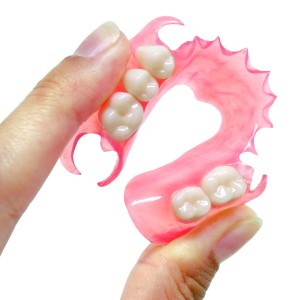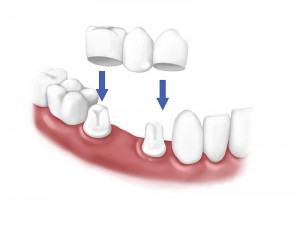Laminates
Laminates are fabricated from porcelain indirectly, in the dental laboratory.
Porcelain laminates have several advantages over composite veneers. Their colour, shape and shine last really long; they are biologically inert and easy to take care of. In addition to the terrific aesthetic benefits, they have a long length of service. Some of their disadvantages are cost and time needed for their fabrication and placement.
Stages of laminate fabrication:
An examination and preparation are carried out first. An impression is made of the prepared teeth and it is sent to the dental laboratory, where future teeth shape is modeled. Temporary laminates are then placed on teeth.
During the second visit, after patient’s approval of laminates’ shape and colour the shells are placed on teeth.
Fixed denture (crown and bridge)
Fixed partial denture is one of the most modern and prospective methods of teeth restoration which allows for placing a dummy tooth on a fiberglass tape, attached to neighbouring teeth and does not require total preparation of the abutment teeth.
Advantages of this technique:
- patient replaces a missing tooth at a single visit to the dentist;
- only thin layers of enamel, where fiberglass tape is placed, are subject to preparation;
- the cost is approximately twice as low as that of porcelain fused to metal dental bridges;
- does not involve removal of the pulp of neighbouring teeth and their reduction.
Nylon dentures
Advantages:
- reduced impact on gums;
- absence of metal components;
- no allergic response (they do not contain monomer);
- good moisture resistance (they do not absorb oral cavity flora);
- they are nearly impossible to break down, but if one gives it a try, it will be impossible to fix the denture. This is their peculiarity, maybe a disadvantage;
- high cosmetic value, due to semi-transparency and small thickness.
Premium class teeth replacement using modern materials and techniques
We offer all types of fixed and removable partial dentures: inlays, laminates, porcelain fused to metal and ceramic crowns and fixed dentures, removable dentures with soft base. Crowns are fabricated indirectly, in a dental laboratory.
Crown is a type of dental restoration, which completely caps the visible part of a tooth and bonded to the tooth using special dental cement.
Crowns are used for several reasons:
- to restore anatomic shape of teeth
- to preserve tooth functions
- to improve the aesthetic look
- to attach fixed dentures (bridges), when crown becomes a component of the device
Dental bridges (fixed partial dentures)
Dental bridge is a non-removable prosthetic device, which is anchored onto teeth using crowns, pin-retained crowns and inlays. The peculiarity of dental bridges is that the gap is bridged with pontics, or dummy teeth. Dental bridges are used for replacing one or several missing teeth.
Dental bridges can be fitted only if there are teeth on each side of the empty space, serving to anchor the false tooth in place. The adjacent anchoring teeth undergo reduction and crowns are placed over them.
The bridge is then anchored on the crowns, and thus replaces the missing teeth. Dental bridges are fabricated indirectly, in a dental laboratory.
Design and placement of dental bridges involves the following stages:
1. Teeth preparation.
A porcelain fused metal crown is 1.4-1.7 mm thick, that is why tooth size must be decreased. The tooth is reduced on all sides, so that the crown, after its placement, can restore shape of the original teeth in a correct alignment and contact with the opposing teeth. Tooth preparation is done under anaesthesia.
When preparing tooth for a crown, the dentist tries not only to reduce its size but also gives it a particular shape. Apart from reshaping, special shoulder is made in cervical part.
2. Strengthening of tooth stump.
Before tooth preparation for crown placement is started, there is often a need for preliminary procedures, like tooth restoration with a pin-retained filling or a cast inlay.
3. Gum retraction and impression tray selection.
A special technique is employed to get a good tooth impression – gum retraction. A thin retraction cord, soaked in a special medical solution, is placed in the sulcus (between the gum tissue and your tooth structure) for 10-15 minutes. It makes it possible to pull back the gum tissue for a small period of time so that the dentist can take an impression which will accurately reflect the condition of your teeth. Next, a suitable impression tray is selected.
4. Making an impression of the teeth.
To accurately model the future crown, taking into consideration both the adjacent and opposing teeth, the dentist makes an impression of not only the causative tooth but also the opposing jaw. Modern dental putty is easy to use and causes discomfort to neither the dentist nor the patient.
5. Making models.
The impression is sent to the dental laboratory, where a plaster casting is made. This casting is a precise model of your teeth.
6. Fabrication of temporary crowns
Temporary crowns are fabricated for the time until the permanent custom-made crowns are ready.
Temporary crowns are necessary to protect your teeth from any harmful exposure (for example, extreme temperatures, if the tooth is still vital) and allow for faster gum healing and restoration of aesthetic look.
Crowns are normally fabricated from a composite. Depending on the given clinical case, they are either fabricated by the dentist or in a dental laboratory. A temporary crown will usually be cemented in place with soft temporary dental cement. This allows easy removal at your next visit to the dentist.
7. Colour check.
Using a special shade guide, your teeth colour is identified and this being considered the shade of your future crown is chosen.
8. Crown fitting
At this stage, the dentist needs to check the following:
- that the crown fits correctly, that is totally caps the tooth,
- that it doesn’t affect patient’s bite,
- shape and colour
After all the checks are finished the dentist will demonstrate the achieved result to you and ask about your opinion.
9. Crown placement.
If you are happy with the restoration and how it looks, the crown is cemented onto tooth. The special cement used for this is placed inside the crown which is then placed over the tooth. Excessive cement is removed using a special tool.
Removable partial denture
Removable partial denture is the principal teeth replacement technique if there is lack of required teeth to serve as support for a bridge (one or both sides), if a big number of teeth or all of them are missing.
Laminar denture – fixed behind teeth with hooks.
Clasp-retained denture – fixed with clasps (snap attachment).



